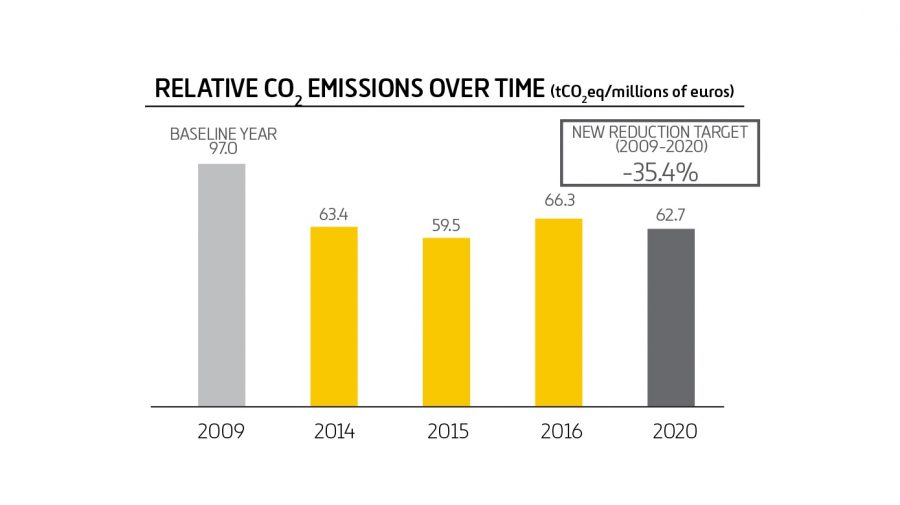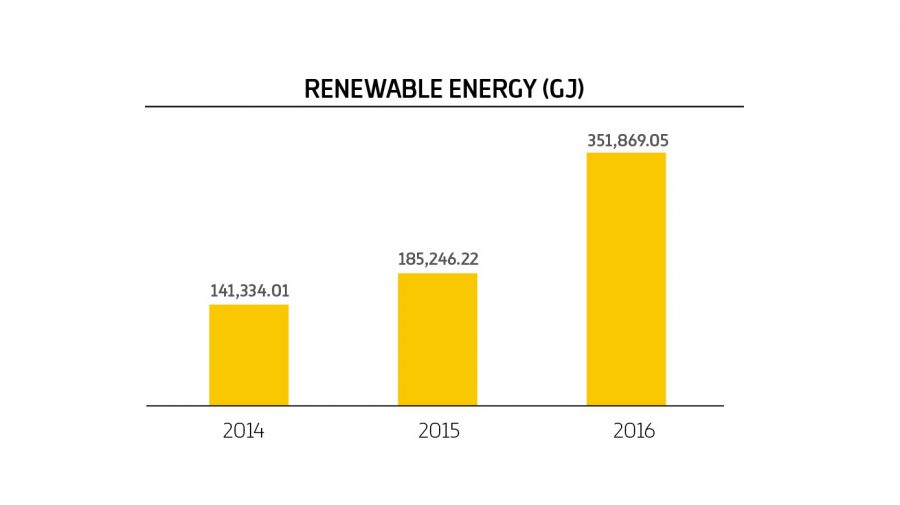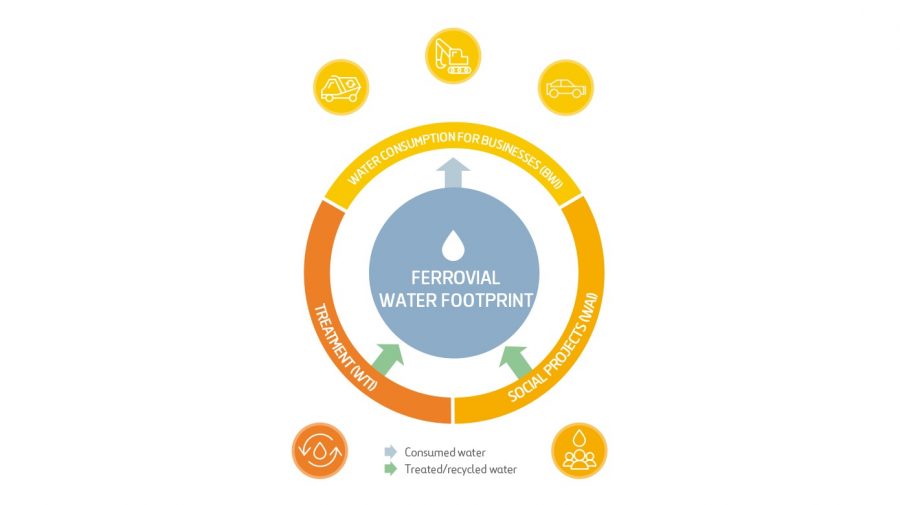The Environment
Ferrovial is firmly committed to reducing its emissions and the environmental impact of its activities. It also promotes the generation of new ideas and business models, to offer its clients and users innovative solutions with a lower impact.
-
C02 Emissions over time
-31.6 % In relative terms (tCO2 eq/M€) (2009-2016) (Scope 1&2) -
C02 Emissions over time
-18.1 % In absolute terms (2009-2016) (Scope 1&2)
The recent entry into force of the Paris Agreement, the first universal agreement against climate change, confirms the commitment of governments to the effective reduction of CO2 leading to low-carbon economies.
Ferrovial is aware of its responsibility in this process. For this reason, its activity is based on two lines of action:
ENVIRONMENTAL IMPACT MANAGEMENT
Climate change and carbon footprint
Ferrovial is engaged in the main forums for analyzing the latest trends and anticipating the legislative changes that will take place in the coming years. Worthy of note is Ferrovial’s presence in the Climate Change Conference in Marrakech (COP22), as well as its representation in groups such as the Prince of Wales’s Corporate Leaders Group and the Spanish Green Growth Group, which it chairs.
In 2016, reflecting its firm commitment with respect to climate change, the company revised its target for reducing CO2, setting one that is much more ambitious. Thus, the relative emission reduction target with respect to Net Revenue (tCO2eq/M€) for 2020 has risen from 21.3% to 35.4% compared with the baseline year 2009. The reduction target for 2016 with respect to the baseline year is 22.52%.
This would mean maintaining Scope 1 & 2 emissions and energy and electricity consumption at the same level as in 2009, despite higher turnover. Nonetheless, a reduction target was established for 2016 in absolute and comparable terms (revenue and intensity) at 56,652 tCO2eq against the figure for 2009 (48,154 tCO2eq and 8,498 tCO2eq, Scope 1 & 2 respectively).
In conclusion, in 2016 the target was achieved and surpassed, with emissions down by 31.66% compared with the baseline year in terms of intensity (9.14 points above the target) and a reduction of 156,790 tCO2eq in absolute terms.
To honor this commitment, Ferrovial developed and implemented actions to reduce emissions in general as well as specific to each business area:
- Incorporation of energy efficiency criteria in purchasing and service subcontracting.
- Sustainable Mobility Strategy for Ferrovial employees. All corporate offices in Spain and the United Kingdom have mobility plans.
- Improved energy efficiency in both industrial vehicle and passenger car fleets.
- Use of cleaner fuels.
- The development of technology and processes to increase emissions avoided.
- Incorporation of energy efficiency measures in buildings used by corporate headquarters.
- Drive toward buying electricity from certified renewable sources. 30.1% of the electricity consumed by Ferrovial comes from renewable sources, which is 41.37% higher than last year’s figures.
More information on Ferrovial’s carbon footprint at www.ferrovial.com.

Fully aware of the challenge undertaken by signing the Paris Agreement to limit global warming to well below 2° and even only 1.5ºC, an analysis has begun on the methods contained in the Science Based Targets (SBT) with a view to ascertaining the targets on the 2030 and 2050 horizons.
A further line of action initiated in 2016 entailed establishing a Carbon Price in the “Shadow pricing” modality as a tool to quantify the risks and opportunities of new investments. This approach considers future changes in market conditions that will increase the cost of carbon emissions and generate changes in the use and need for current products and services.
Water footprint
The World Economic Forum has identified water as one of the greatest causes of conflict worldwide. The mitigation of this risk clearly involves finding solutions to the increasing demands for drinking water, the deterioration in water quality caused by contamination and the effects of flooding and extreme weather events.
Given its role as consumer and provider of services associated with water resources, Ferrovial began calculating its “water footprint” in 2015. This project was implemented in two stages, the first consisting of defining a calculation and reporting method for consumption and emissions, and the second consisting of analyzing the risks and opportunities related with the resource.
The company has developed a specific methodology based on the principles of the “Water Footprint Assessment Manual” (WFM), “Global Water Tool” (GWT) and GRI-G4. These methods consider aspects such as water stress in the country, impact on water resources and quality, and water accessibility. Water Footprint data were published for the first time in 2016 with a scope of 100%.
Ferrovial first applied for the CDP Water program assessment in 2016 and obtained a score of A-, which is a recognition of the company’s strategy and efforts.

Ferrovial’s Water Footprint comprises three indices:
- BWI: Business Water Index: 4,146,441. Water footprint related to the water consumption and discharge in activities carried out by all the business units at Ferrovial.
- WTI: Water Treatment Index: -322,183,025. The impact of Cadagua water treatment processes and Ferrovial Services and Amey landfill leachates on Ferrovial’s footprint.
- WAI: Water Access Index: -413,738. The impact that water supply projects for communities in developing nations within the company’s Social Action programs have on the Ferrovial water footprint
Biodiversity and Natural Capital
Through the “Ferrovial, Natural Capital” program, the company carries out several biodiversity projects for not only assessing and mitigating the impact on natural spaces or ecosystems affected by its activity, but also anticipating market trends and, if applicable, making the most of any opportunities that arise.
In 2016, Ferrovial worked with several scientific institutions (CSIC, Rey Juan Carlos University in Madrid, USAL) to develop a corporate methodology for measuring the company’s impact on biodiversity. The aim is to have a proven assessment method for all corporate activities that could be a useful tool in decision-making, incorporating the “No Net Loss of Biodiversity” criterion. Once designed, the methodology will begin to be tested on specific contracts during 2017 and then automated to subsequently have the assessment conducted systematically.
In this regard, Ferrovial Agroman has had a specific procedure in place for several years for quantitatively assessing the risks associated with areas under protection or of high ecological value, and implementing the measures necessary to mitigate and control them.
Ferrovial likewise participates in the Spanish Companies and Biodiversity Initiative, a public-private partnership project with the Biodiversity Foundation and the Spanish Ministry of Agriculture, Fisheries, Food and the Environment. In addition to supporting the various initiatives undertaken, the company aligns its biodiversity strategy with Spanish and European policies, objectives and plans.
Regarding the emerging “biodiversity markets”, Ferrovial has been taking further steps in various existing offsetting mechanisms. Ferrovial is monitoring the drafting of the new legal frameworks in countries such as Spain and the United Kingdom.
In 2016, Ferrovial worked on 16 projects subject to Environmental Impact Statements (or equivalent figures) according to each country’s legal framework. The existence of protected species resulted in restrictions in ten of them, 16 were situated in Natural Areas affected by some sort of environmental protection arrangement, and nine had high-quality watercourses nearby.
Reducing the environmental impact caused by the activity
Ferrovial maintains a steady goal to annually increase the recycling rate by 5%. There was a substantial increase in recycled materials in 2016, which once again confirms the trends in management policies with a priority on recycling. This trend is also in line with the start of new construction projects with an exceptional volume of recyclable materials.

GENERATION OF NEW BUSINESS IDEAS AND MODELS
The company leverages its role in the most important global forums on climate change, energy transition and the loss of biodiversity to anticipate trends in these areas and identify new opportunities and business models.
In particular, work is underway to improve energy efficiency in buildings, the intelligent management of cities, challenges of the circular economy, biodiversity markets, lowemissions mobility, waste treatment and the corresponding energy production (energy from waste). Thus, new ideas are already generating business and value for Ferrovial, or will do so in the very near future.
Milestones
- Revision of the relative emission target for co2 -35.41%
- Inclusion in the leadership category of the 2016 carbon disclosure project (CDP):
- “Climate a list” in the Climate Change Report
- Global Supply Chain Report
- Global Water Report
- Implementation of the method for calculating the water footprint through bwi, wti and wai (refer to the water footprint for further details)
- Start of the “no net biodiversity loss” assessment
20.19 STRATEGIC CR PLAN
- Reduce the carbon footprint through a public commitment to emissions reduction
- Water Footprint: implement and verify a method for calculating it with a coverage of 100%
- Reduce the impact on the biodiversity and natural capital under a criterion of “No Net Biodiversity Loss”
- Promote circular economy
Carbon Disclosure Project

Ferrovial has again been recognized for its climate change strategy, included in the Climate A List in the Climate Change edition, which ranks companies with best practices for reducing emissions and their management for mitigating the effects of climate change. In addition, Ferrovial has become a bellwether in the Supplier Climate Performance Leadership Index (SCPLI), certifying excellence as a supplier of products and services with low carbon-emission business models. In its first year, Ferrovial applied for the Water program assessment and obtained a score of A-.


